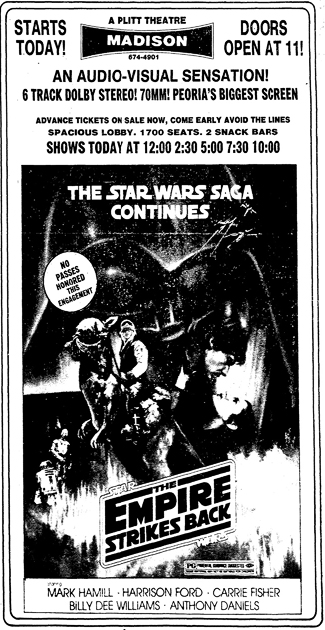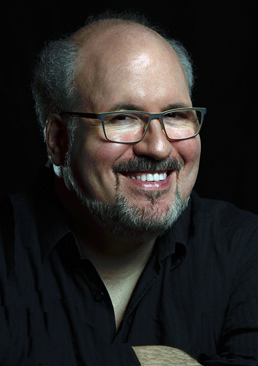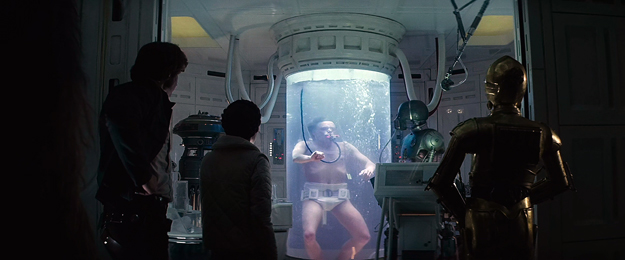“On my thirteenth viewing, which was the first time I saw it at a different theater than the one I’d gone to since opening day, I knew there were noticeable changes when the final scene began with different music.” — film music historian Mike Matessino
The Digital Bits and History, Legacy & Showmanship are pleased to present a continuation of our 40th anniversary coverage of the release of The Empire Strikes Back, the middle act of George Lucas’s original Star Wars trilogy and one of the most celebrated and beloved sequels of all time. Part One of our Empire 40th coverage appeared back in May.
George Lucas’s penchant for making revisions to his work is about as legendary as his movies. The majority of Lucas’s alterations have occurred years after his films’ original releases. With The Empire Strikes Back, however, the first (of several rounds of) revisions were actually made while the movie was in first release, and it is this lesser-known aspect of the otherwise very-well-known production that is the subject of this column. [Read on here...]
The revisions were not publicized and might never have been noticed if it weren’t for some eagle-eyed fans who managed to attend screenings in different theaters and saw the movie again… and again… and again. And we here at The Bits have managed to snag two such fans who have plenty to say about their experiences seeing Empire in a new Q&A.
Initially, in May 1980, The Empire Strikes Back opened primarily in larger markets and exclusively in 70-millimeter format with discrete magnetic audio (save for two drive-in theaters in Southern California). The reasons Lucasfilm and Fox opted for launching as a 70mm exclusive included (1) ensuring the highest quality presentation available to the moviegoer at the time, (2) capitalizing on the increase in 70mm and Dolby Stereo-equipped theaters since the release of the first Star Wars movie, and (3) reducing the chances of the movie being pirated for the then fledgling home video market.

At the time of Empire’s production, its 70mm print order was the industry’s largest ever (for a one-time print order). Thus, the lead time to manufacture those prints (i.e. optically enlarging to a 65mm intermediate element, printing, striping, sounding, QCing, shipping) necessitated the production “lock” the movie several weeks sooner than if it were being distributed only in standard 35mm. What transpired, in essence, is Lucas and Company “unlocked” the movie and kept working on it!
 The majority of theaters destined to screen Empire would not do so until the film’s general release which commenced four weeks after the 70mm limited-market launch and continued (depending on market size and other factors) throughout the summer and autumn months of 1980, and 99 percent of the general-release bookings were in theaters sent a 35mm print (some in Dolby Stereo; most in mono). Knowing the 70mm prints would have a one-month head start playing in theaters, the filmmakers capitalized on that window of time to fix things deemed not quite right before the majority of release prints got struck.
The majority of theaters destined to screen Empire would not do so until the film’s general release which commenced four weeks after the 70mm limited-market launch and continued (depending on market size and other factors) throughout the summer and autumn months of 1980, and 99 percent of the general-release bookings were in theaters sent a 35mm print (some in Dolby Stereo; most in mono). Knowing the 70mm prints would have a one-month head start playing in theaters, the filmmakers capitalized on that window of time to fix things deemed not quite right before the majority of release prints got struck.
So… what was changed? The revised material included three newly-produced shots added to the final scene (along with an extra line of dialogue, a different take used for one shot, and music tracked from another scene to account for the increase in running time) as well as some VFX enhancements (the Millennium Falcon’s radar dish added to a shot, re-compositing shot of Imperial Scout Walker, transmission of holographic Emperor fading in, etc). Other tweaks were editorial in nature, such as revising two scene transitions from a wipe to a straight cut and the exchange between Vader and Luke on the Falcon before the triumphant jump to hyperspace changed from straight cuts to quick dissolves. In addition, the medical center scene at the Rebel Base on Hoth following Luke’s rescue was extended with a shot of Luke being observed through a window. As well, there were some dialogue and sound effects substitutions and changes. (Note this coverage does not address the multitude of tweaks made for the 1997 Special Edition re-release and subsequent home media releases. But that’s another story!)
Now, some context for this column: In May 2020, Star Wars.com (run by Lucasfilm, the company that produced the movie that is the subject of this column) as part of their Empire 40th coverage posted an article (which in turn was based upon extracts from J.W. Rinzler’s 2010 book The Making of The Empire Strikes Back) that misrepresented this situation. And, as is so often the case today, numerous web outlets created copycat articles which, of course, provided the exact same story points and quotes… and omissions. While these articles emphasized the visual tweaks to the final scene, they ignored the numerous other revisions made throughout the movie (described in the previous paragraph), giving the false impression those “three new shots” were the only difference between Empire’s 35mm and 70mm prints. Even in describing the three new shots, depending on the coverage, little-to-no mention was made pertaining to the audio to account for the increased running time. More surprising, the SW.com coverage erred in identifying how many 70mm prints were made for Empire. The SW.com piece claimed Empire opened with only forty-one 70mm prints in sixteen cities. By our count, as cataloged in our earlier coverage, in North America there were one-hundred thirty-six 70mm prints in over 75 markets. (A dozen of those 70mm prints were held for expansion waves. Plus, there were additional 70mm prints destined for theaters in key international markets.) And speaking of expansion waves, the widely-relied-upon Internet Movie Database (IMDb) claims the expansion/general release in the United States commenced June 20th when in fact the earliest such bookings commenced June 18th.
The irony to all of this is that many moviegoers in the largest locales (i.e. longest-running and highest-grossing) never actually saw the changes. The revisions are believed to have been reflected only in the 35mm prints as no record can be found of the 70mm prints (or even selected reels) ever being re-printed to reflect the tweaks. By the time Empire finally arrived on the home video market in 1984 (a much longer-than-typical theatrical-to-video window of that era) — and in the ensuing decades — the fact the movie existed in different versions had largely become forgotten since the home media releases have always been based upon the revised 35mm version.
The tradeoff, ultimately, in the original theatrical release at least, was more of a sideways move in that the 35s were more complete and fine-tuned but the 70s unquestionably touted a superior sound mix and for the most part played larger, better maintained theaters.
So the big question, of course, is: Did these changes make a difference to the quality of the filmmaking or to one’s enjoyment of The Empire Strikes Back? Let’s find out…
The Q&A participants for this column are…
 Mike Matessino is an accomplished music producer, mixer, editor, mastering engineer and film music historian and has been associated with dozens of CD soundtrack projects including The Star Wars Trilogy (1977-83 + 97 SE). His other projects include 1941, Back to the Future, Close Encounters of the Third Kind, The Disaster Movie Collection (Earthquake, The Poseidon Adventure, The Towering Inferno), E.T. The Extra-Terrestrial, Harry Potter, Home Alone, Jaws, Jurassic Park, Schindler’s List, Star Trek: The Motion Picture, and Superman.
Mike Matessino is an accomplished music producer, mixer, editor, mastering engineer and film music historian and has been associated with dozens of CD soundtrack projects including The Star Wars Trilogy (1977-83 + 97 SE). His other projects include 1941, Back to the Future, Close Encounters of the Third Kind, The Disaster Movie Collection (Earthquake, The Poseidon Adventure, The Towering Inferno), E.T. The Extra-Terrestrial, Harry Potter, Home Alone, Jaws, Jurassic Park, Schindler’s List, Star Trek: The Motion Picture, and Superman.
He has written for Film Score Monthly and worked on the film screenings with live concert performances of the scores for Close Encounters of the Third Kind, Jaws, and Superman. As well, he was the Restoration Supervisor for The Director’s Edition of Star Trek: The Motion Picture and directed behind-the-scenes documentaries on The Sound of Music, Alien, The Last Starfighter, and John Carpenter’s The Thing, which have been included as Value Added Material on some of those films’ LaserDisc, DVD and/or Blu-ray releases.
 Saul Pincus an award-winning writer, director and editor.
Saul Pincus an award-winning writer, director and editor.
He co-wrote and directed Nocturne, a multi-award-winning feature film about an insomniac who falls in love with a sleepwalker; Nocturne premiered at the Warsaw Film Festival and is available on iTunes, Amazon, Google Play, and X-Box in the United States, United Kingdom, Canada, Australia, and four-dozen other countries around the world.
Saul contributed extensively to Film Score Monthly magazine and FSM Online, and his foremost collaboration as film editor, with veteran director Sidney J. Furie (The Ipcress File, Lady Sings the Blues), spanned eight films and sixteen years.
The interviews were conducted separately and have been edited into a “roundtable” conversation format.
===
Michael Coate (The Digital Bits): How many times did you see The Empire Strikes Back in its original release?
Mike Matessino: Twenty-seven during the summer of 1980. (To date, fifty-five.) Amazingly I kept a record of viewings: Of the first twenty-six between May 21st and September 13th: viewings 1-12, 14-17, 19-21, 23, and 25-26 were at Central Plaza in Yonkers, New York. Viewings 13, 14, 18, 22 and 24 were at RKO Quad in New Rochelle. And number 27 was at Loews Astor Plaza in Manhattan on September 20th.
Saul Pincus: The 70mm print of The Empire Strikes Back played the cavernous, single-screen Place du Canada in my hometown of Montréal upon its initial release; that summer I saw it there three times. The first time I experienced Empire in 35mm anamorphic Dolby A was the first day of its first re-release, in late July 1981, at the Decarie Square two-plex. That fall I saw a scratched-up 35mm Empire print during its brief rep run at The Seville Theatre, just around the corner from the old Montréal Forum. I saw it twice again in October 1982 when the Star Wars / Empire 70mm double feature (complete with a 70mm Revenge of the Jedi teaser) played the city’s most stunning and acoustically impressive cinema, the Imperial, and once more when this double feature was moved to The Palace Theatre in January 1983. In April of ’86, I saw it again at the Imperial, this time as part of a Star Wars / Empire / Jedi 70mm triple feature. This would be the last time I saw Empire on film until its Special Edition re-release in 1997, though I owned the pan-and-scan as well as letterbox VHS versions, as well as The Definitive Edition CAV Laserdisc box set between 1985 and 1994; needless to say, I wore that home media out!
Coate: When did you first become aware that there were content-related differences between the 70mm and 35mm versions of Empire and not just the more-obvious presentation-related differences (i.e. superior projection and sound quality)?
Matessino: Not until my 13th viewing on July 2nd 1980, which was the first time I saw it at a different theater than the one I’d gone to since opening day.
Pincus: I didn’t have a frame of reference till I saw it in 35mm for the first time the summer of ’81. I was sure it was different, but I didn’t make a mental list till I saw a 35mm print again that fall at The Seville. I cross-checked the experience with my next viewing, at the Star Wars / Empire 70mm double feature in October ’82, and I’d run the beats alongside the book of the script, titled The Empire Strikes Back Notebook — which also contained a large selection of storyboards. They weren’t complete, but the films were obviously so quotable and visually distinctive that you’d feel if a beat was missing, or lengthened. Also, Empire contains the arguably saga-best John Williams score and Ben Burtt’s parallel aural world-building, which combines to result in a distinctive moment-to-moment impact and sensory imprint quite unlike many other films.





